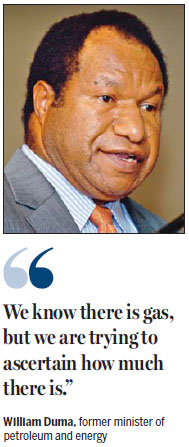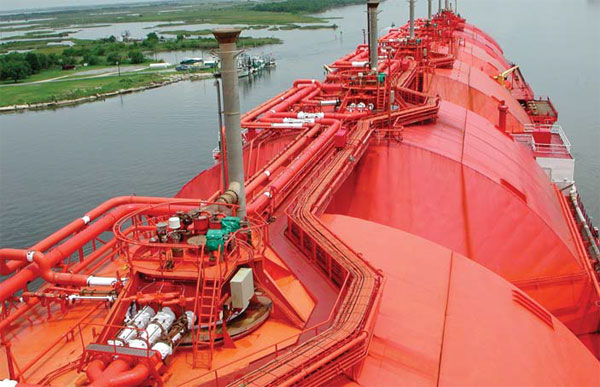Fueling growth across Papua New Guinea
|
Papua New Guinea expects its major liquefied natural gas project to attract a lot of international investors. Provided to China Daily |
|
The Grand Papua Hotel in Port Moresby offers convenience to businesspeople and visitors. Provided to China Daily |
A rise in Chinese investment is leading to development of the resource-rich country
With more than 60 percent of the landmass in Papua New Guinea still to be explored, particularly in the oil and gas sector, it is not surprising that the country is attracting so much international interest.
In an interview last year, former minister of petroleum and energy, William Duma - now minister of transport - discussed the nation's focus on oil and gas projects.
"The country boasts four petroleum basins: the Highlands Basin, the Papuan Basin, the Momase Basin and the Islands Basin. For now, we are only concentrating on the Papuan and Highlands basins as it is there you will find most of the discoveries of gas, specifically in Hide, Juha, Angore and Kutubu that are in the Highlands. Further down, you have the InterOil Elk Antelope discovery in the Papuan Basin, with a number of smaller discoveries," Duma said.
"We have not yet gone offshore, which only serves to highlight the untapped potential still remaining to be discovered. We offer one of the best fiscal mechanisms in the region - even better than Australia - in the sense that we give generous tax concessions, and we are not looking to impose additional profit tax.
"We have what is known as the concession mechanism, where we allow the investor to take the risk, spend the money and look for oil and gas. If he finds it, he keeps everything - we just buy-in 22.5 percent and collect taxes, whereas other countries in the region have a production-sharing mechanism, where the host government allows the investor to find oil, and once he finds it, then the government will negotiate the price, or a hybrid of the two.
"The country's energy mix includes hydropower, geothermal energy, and of course we have gas. Right now, we are solely focusing on oil and gas, but there are some very interesting opportunities in the geothermal sector. We are currently developing policies that have already been approved, but will become effective in the near future. There is also some interest from private companies who are interested in going into biofuels by extracting oil from palm oil and coconut, but there is not much activity in that area.
"The Exxon-Mobil investment capacity is slated to produce 6.9 million metric tons of liquefied natural gas per year. There is 255 billion cubic meters of gas, which was been dedicated to the Exxon-Mobil-led project and we have gas supply agreements with Sinopec, a number of companies from Japan led by TEPCO, and an oil company from Taiwan. So we have three major buyers internationally, and what is key is that these are long-term buyers, with 30-year agreements. Angore and Juha, and the bulk of Hides, are not yet dedicated to this project, as we have reserved them, so drilling and exploration will still continue.
"We know there is gas, but we are trying to ascertain how much there is. In the agreement we signed with Exxon, we inserted a clause that states the minute more gas is found, it will automatically trigger the renewal clause and we go back to the negotiating table.
"This is because we will be looking at gas with a quantity much higher than 255 billion cubic meters - the Gulf area of the Papuan Basin is a gas-prone area. It is quite probable that we will find more gas there once we explore it."
Realistic goal
Duma said the liquefied natural gas project is expected to increase GDP up to 20 percent and raise overall living standards.
"It is a realistic goal," he added. "When you talk about gas, you have to bear in mind that it is not subject to short-term price fluctuations. In most cases, you will find that the liquefied natural gas agreements are usually for 30 to 40 years, locked into an agreed price."
Duma said the LNG project is set to supply to four major customers, two of them being Sinopec with about 2 million metric tons per annum and the Chinese Petroleum Corp in Taiwan with about 1.2 million tons per annum.
He added that this project will further strengthen China-Papua New Guinea relationships and increase bilateral trade, especially with China's $2.8 billion loan for infrastructure.
"China has always been a very big importer of raw materials from Papua New Guinea, particularly timber; our tropical hardwood timber has always been a favorite for Chinese companies, so there has always been a bilateral relationship. Now, however, with the long-term gas agreements with Sinopec, trade will increase even more."
He said there are even more opportunities for Chinese investors to get involved in exploration and greenfield projects.

"Because of our fiscal regime, Chinese companies can only benefit if they come in and get involved right from the start rather than waiting for someone else to come in and build the foundation and then trying to buy into that project.
"Usually we find that once a project is up and running, it is much harder to buy into it, which is why I encourage more Chinese companies to get involved from the start.
"We are responsible for the majority of the revenue of this country. While some industries measure their revenues in the hundreds of millions of dollars, we measure it in billions.
"We are the single largest revenue owners of this country, and that is likely to continue for the next 10 to 15 years. The industry is in a good enough state and has a very attractive fiscal system, so it can only grow from here."
The LNG project team has worked in challenging conditions, including remote locations, steep terrains and areas that sees a lot of rainfall, flooding and is filled with swampland to build this pipeline.
As Exxon-Mobil PNG Limited senior project manager Sam Roxburgh said: "The pipeline was routed and constructed to avoid critical wildlife habitat and cultural areas such as sacred or archaeological sites.
"Also important were the efforts to minimize the project's environmental footprint."
Beating the challenges
Although all eyes are presently focused on this huge project, the government is keen for investors to explore other oil and gas opportunities.
Famous for its natural beauty and thriving traditional cultures, Hela province was only formed in 2012 when a trio of districts decided to leave the Southern Highlands district to maximize the benefits of finding LNG in Papua New Guinea.
Under the leadership of Governor Anderson Agiru, the province is 10,500 square kilometers and has a population of about 350,000 people. It has drawn up a development blueprint that focuses on new infrastructure, agriculture, hydropower, better education and empowerment of local residents.
During his first annual budget announcement in January 2013, Agiru said his strategy is about "putting the right foundations in place for the development goals which will anchor Hela's future".
Agiru plans to develop - with the vast proceeds of the Papua New Guinea LNG project - people's farming skills and invest in advanced agricultural technology. Hela will also become home to two large agro-industrial centers near the provincial capital Tari.
"I've been talking about the development of our agriculture industry for a long, long time," Agiru said. "There is an international airport at Komo where we can bring in large planes to take vegetables fresh from the farm straight into China in six or seven hours. China are very aggressive in what they do. When I say aggressive, once you make a commitment to do something, they will go for it. "
Chinese partners
Agiru is particularly keen to maximize the region's untapped potential with the help of Chinese investors who he respects and admires.
"China is a world leader in hydropower and so the development of the Purari Hydro project that will generate 600-700 MW is an ideal project for a Chinese company," he said. "We need the Chinese people, technology and money."
"I introduced LNG to this country, then fought for it and delivered it. Now LNG is here. I don't see any more challenges there. The only challenge left is developing a petrochemical industry in Papua New Guinea.
"Now I'm going to argue for this and five years from today, I want to see a petrochemical industry here. The Chinese are very enterprising. They know how to build small to medium-sized enterprises. That is the great engine of our country. It creates a great middle class who pays taxes and creates employment. So, all those cottage industries the Chinese have built, the passion to work hard. That is what we need in Papua New Guinea.
"The Chinese industries in the manufacturing sector that make small products, fix computers, produce all those gadgets, doing research - these are what we need.
"I think we need Chinese also to invest in our country and then create small to medium-sized enterprises. I would like to see a lot of partnerships and if the Chinese want to look for a place to invest, my province is available."
Global support
Leading global financial institutions such as the World Bank and the International Monetary Fund continue to play an important role in Papua New Guinea through the financing of loans and payments for infrastructure and socioeconomic projects.
Positioned in northwestern Papua New Guinea, Sandaun province covers an area of about 36,200 square kilometers and has a population of about 200,000, most of whom live in the capital Vanimo.
Under the leadership of Governor Akmat Mai, Sandaun is investing heavily in new highways as the region looks to boost the flow of goods and services and become a springboard for trade and commerce in the wider Asia-Pacific region.
The governor is especially passionate about attracting fresh Chinese investment to his province and is eager to develop a range of large infrastructure projects currently on the drawing board - including a major new seaport - with the help of Chinese investors and construction companies.
He also wants to realize the potential of Sandaun's agricultural industry and is particularly interested in growing vast quantities of rice for export to foreign markets like China.
"I want the Chinese to settle down and start their businesses in my province," he said.
"If China wants to invest in Papua New Guinea, they must invest in Vanimo because its proximity to Asia means it can be a launchpad for trade and commerce and economic development between the Pacific and Asia. I would like China to invest in infrastructure development, agricultural sectors such as cocoa, cattle, pig farms and fisheries, as well as the mining sector. We have a lot of prospects in gold, copper, oil and gas. Maybe in five years, Sandaun province will be producing the next wave of energy for Papua New Guinea."
Finally, visitors to Port Moresby for the Pacific Games, the APEC Summit, congress or general business will find five-star facilities and comfort at the Grand Papua Hotel.
Situated in the center of the city, the hotel offers a day spa, two restaurants, two bars and a swimming pool. "We intend to keep ourselves competitive by bringing in international expertise," said general manager Alex Wilson. Each of the 160 rooms boasts sea views from a private balcony. Guests also enjoy a fitness center, a hot tub and a sauna. Grand Papua Resort is 20 minutes from the airport and a 10-minute walk from Ela Beach.
InFocus provided this story.
(China Daily 06/29/2015 page22)
















